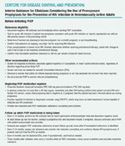HIV Prophylaxis: The Promise and Potential Pitfalls
Pre-exposure prophylaxis (PrEP) against the risk of HIV infection is now approved by the FDA, supported by three randomized trials. But its use is controversial. What are the implications for primary care?
You know something is big when The New England Journal of Medicine (NEJM) publishes the results of three randomized clinical studies, a commentary, and interactive case all in one issue. And pre-exposure prophylaxis (PrEP) for HIV prevention is big.
The Food and Drug Administration (FDA) in July approved tenofovir disoproxil fumarate plus emtricitabine (TDF/FTC), or Truvada, for use as PrEP among sexually active adults at risk for HIV infection. A few weeks later, during the 2012 International World AIDS Congress, NEJM put the issue into perspective with the formal results of three studies on PrEP that contributed to Truvada’s approval.
Controversy Over PrEP
It should come as no surprise that even the clinical community is divided on the use of PrEP, as the commentary to the interactive case study the NEJM published showed. “People need to understand that everybody has to take responsibility of their own behavior, and do not fall in the misconception that ‘a pill cures all',” wrote one Indiana physician.
Others asked for cost/benefit data, since a year of PrEP could cost about $24,000. “The question is as simple as: how much money do I have to invest in PrEP in order to prevent a new infection, and what is the cost of both strategies,” he wrote. “Can governments afford this cost?”
TABLE

CDC Interim Guidelines on PrEP
Other questions remain, such as why there were such disparate results between various PrEP trials; who will cover the cost of PrEP; and whether its use will exacerbate the issue of viral resistance already observed in patients who are not completely adherent with ART.
What does all this mean for primary care physicians? The following responses offer perspective from the lead author of one of the studies, Jared M. Baeten, MD, PhD, an associate professor in the Department of Global Health and Medicine at the University of Washington in Seattle.
How effective is PrEP?
The clinical trials of PrEP demonstrated clearly that, in populations at high risk of getting infected (such as men who have sex with men, those who have an infected partner, and heterosexuals living in settings where HIV is prevalent), all received HIV protection from taking it. What’s really clear is that those who took it and were adherent to the medication received substantially stronger benefit than those who were less adherent or whose adherence was poor.
Which means adherence is a potential issue, right?
Taking daily medications is tough in general; every primary care physician knows this. And taking medications for diseases that one doesn’t have (or one doesn't really feel one has) is even tougher. But one thing that is different about PrEP than, say, a statin for cholesterol, is that PrEP is likely to be time-limited for most people, used only during periods in their lives when the risk is greater. A good analogy is oral contraceptives; you take them when your risk of pregnancy is greatest, and don’t take them if that risk is not high.
So PrEP presents a different paradigm from treating HIV once someone is infected?
Where the initiation of medication means embarking on a life-long treatment plan, PrEP would be something for initial periods. However, you have to be careful when you talk about being “on” and “off.” It would be “on” for months or years, not weeks. But as risks change, patients could come off it and if risks change again, go back on.
How do primary care physicians decide which patients are right for PrEP?
The first thing required is being able to have a risk discussion with the patient to determine who is most appropriate for it. It is not appropriate for those who are not at risk of getting HIV. So the first talking point is about the individual’s HIV risk. The obvious first place to start is with gay and bisexual men who have ongoing behavioral risks that could put them at risk for HIV. For instance, a syphilis infection is a perfect entry point for a discussion of HIV and PrEP.
Is there concern that people on PrEP will get a false sense of security and stop using condoms?
That’s a common question that comes up when talking about PrEP. But in the clinical trials so far, both among men who have sex with men and among those in the heterosexual studies, those who started PrEP actually improved their condom use. That’s because part of the requirement to start PrEP is to have an HIV test about every 3 months. So having the test and discussing other behavioral choices for HIV prevention on a regular basis is risk-reducing.
What about side effects?
The most common side effects in clinical trials were gastrointestinal, principally in the first month and really in a minority of patients. The risk of serious side effects was no different than placebo in the trials. There is a rare risk of kidney damage with Truvada when used in HIV-positive patients, so it is important that physicians monitor their HIV-negative patients receiving PrEP for renal function.